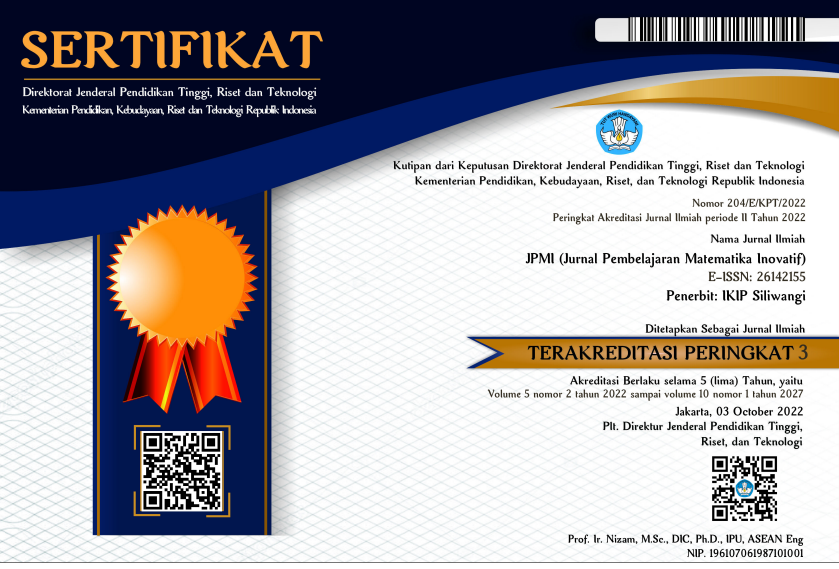PENERAPAN MODEL PEMBELAJARAN PACE DALAM MENINGKATKAN KEMAMPUAN MENGGAMBAR MAHASISWA PADA KONSEP VEKTOR
DOI:
https://doi.org/10.22460/jpmi.v5i2.10088Keywords:
PACE Learning Model, Drawing Ability, VectorAbstract
Vocational education is an educational program that aims to prepare personnel who can establish expertise and skills in their field. For example, students majoring in civil engineering are expected to master skills in drawing designs and measuring distances and directions. In basic courses, student will take physics and mathematics courses, where one of the concepts studied is measuring the size of angles and the resultant of several vectors. The purpose of this study is to describe the application of the PACE learning model to improve the drawing skills of students majoring in civil engineering. The type of research used is descriptive research. The research subject first semester students of the Civil Engineering Department for the 2021/2022 academic year, totaling 62 people. Data analysis using SPSS software with descriptive test. After students have learned, most of the 45 students (75%) can use arcs well, and put the initial position of a vector’s distance, and continue with the second, third, anda resultant vectors with the correct direction and angle positions. The application of the PACE learning model has a significant effect on students’ drawing skills in vector material. Students not only acquire cognitive knowledge, but have affective and spicomotor skills in terms of drawing and using rules and arcs.
References
Aryadi, D., & Ahmatika, D. (2018). Penerapan Model Pembelajaran PACE (Project, Activity, Cooperative Learning, Exercise) untuk Meningkatkan Kemampuan Pembuktian Matematis Peserta Didik SMA. UNINUS Journal Published, 3(7), 92–98.
Aswan, N., & Fadhillah, Y. (2022). Pengaruh Penerapan Pembelajaran Model PACE Terhadap Hasil Belajar Statistik. MIND : Jurnal Ilmu Pendidikan Dan Budaya, 2(1), 1–7.
Dewiatmini, P. (2010). Upaya Meningkatkan Pemahaman Konsep Matematika pada Pokok Bahasan Himpunan Siswa Kelas VII A SMP Negeri 14 Yogyakarta dengan Penerapan …. Fakultas Matematika Dan Ilmu Pengetahuan Alam.
Haswati, D., Aini, R. N., Selpiyani, S., & Permadi, U. N. (2019). Pengaruh Model Pembelajaran PACE terhadap Kemampuan Pemahaman Konsep Matematika Siswa Kelas XI. Jurnal Tadris Matematika, 2(2), 101–110. https://doi.org/10.21274/jtm.2019.2.2.101-110
KA Stround & Erwin Sucipto. (1996). Matematika untuk Teknik (Ketiga). Jakarta: Erlangga.
Kurniawan, B. R., Saputri, D. E., & Shoiqin, M. I. (2019). Analisis Pemahaman Konsep Mahasiswa pada Topik Vektor. Efektor, 6(2), 107–114.
Lestari, N. A. (2018). Implementasi Pembelajaran Matematika Model PACE Untuk Meningkatkan Kemampuan Pembuktian Matematis Pada Mata Kuliah Aljabar Abstrak Mahasiswa S1 Pendidikan Matematika FKIP Universitas Bengkulu. Jurnal Equation: Teori Dan Penelitian Pendidikan Matematika, 1(1), 81–94.
Listiani, T. (2020). Penggunaan Model PACE dalam Pembelajaran Geometri Topik Bangun Ruang. Mosharafa: Jurnal Pendidikan Matematika, 9(3), 407–418. https://doi.org/10.31980/mosharafa.v9i3.711
Raharjo, J. F., & Sulaiman, H. (2017). Mengembangkan Kemampuan Pemahaman Konsep Matematika Diskrit Dan Pembentukan Karakter Konstruktivis Mahasiswa Melalui Pengembangan Bahan Ajar Berbantuan Aplikasi Education Edmodo Bermodelkan Progresif Pace (Project, Activity, Cooperative and Exercise). Teorema, 2(1), 47. https://doi.org/10.25157/.v2i1.569
Rahman, A. A., & Yunita, A. (2018). Penerapan Model Pembelajaran Pace Untuk Meningkatkan Kemampuan Pembuktian Matematika Siswa di Kelas VII SMP Materi Geometri. Maju, 5(1), 27–38.
Sari, W. P., Suyanto, E., & Suana, W. (2017). Analisis Pemahaman Konsep Vektor pada Siswa Sekolah Menengah Atas. Jurnal Ilmiah Pendidikan Fisika Al-BiRuNi, 6(2), 159–168. https://doi.org/10.24042/jipfalbiruni.v6i2.1743
Sear, Francis W., Zemansky, Mark W., Young, H. D. (2002). Fisika Universitas (10th ed.; M. S. Hilarius Wibi H., S.T., Lemeda Simarmata, S.T., Amalia Safitri, S.TP., ed.). Jakarta: Erlangga.
Serway, Raymond A. & Jewett, J. W. (2004). Fisika untuk Sains dan Teknik (6th ed.; J. W. Serway, Raymond A., & Jewtt, ed.). Jakarta: Salemba Teknika.
Sukadi, E. (2016). Deskripsi penguasaan konsep vektor dan jenis kesalahannya ditinjau dari tingkat pencapaian kognitif pada mahasiswa pendidikan fisika. Jurnal Pendidikan Informatika Dan Sains, 5(1), 27–39.
Sukirman. (2019). Analisis Vektor. Jakarta: Universitas Terbuka.
Zuhrotul’Aini, A. (2017). Analisis Kesalahan Mahasiswa dalam Menyelesaikan Soal Analisa Vektor di STKIP PGRI Nganjuk. Jurnal Dharma Pendidikan STKIP PGRI Nganjuk, 12(1), 34–46.

















